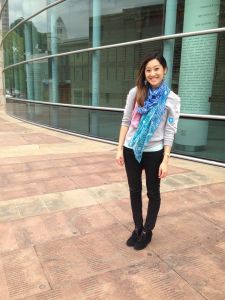
Founded in 2011, Kizuna is a nonprofit organization based in Little Tokyo whose mission is “to build a future for our community through the education, empowerment, and engagement of the next generation.” Through a variety of workshops, projects, and initiatives, Kizuna teaches leadership and community service skills as well as Japanese American values and cultural practices to Nikkei youth of all ages.
At the 2017 Oshogatsu Family Festival, JANM hosted Kizuna’s story time reading and signing of their recently published children’s book, Thank You Very Mochi (available for purchase at the JANM Store). We will also be partnering with them to present our next JANM Free Family Day on Saturday, April 8. The event will celebrate Japanese American history and Kizuna staff will be on hand to lead craft activities, a spam musubi workshop, and story time readings.
This week, we sat down with Kizuna director Craig Ishii via email to find out more about the organization and what it does.

JANM: You’ve been going strong now for six years. Please tell us the story of how and why Kizuna was founded.
Craig Ishii: Several of us had been working at different community-based nonprofits for some time—Little Tokyo Service Center, Japanese American Cultural and Community Center, Japanese American Citizens League, etc. During our tenures with those organizations, it became clear that the community was looking for involvement from the next generation, but there was a general lack of knowledge and practice on how to do this. So in 2011, we brought our heads together and created the organization. We were not experts in this arena, but we had the drive. We went through several names before we found the name “Kizuna.”
When we were first getting off the ground, we had no office and no resources, but we had our networks, a clear vision, and nonprofit building skills. In addition to our years of working in nonprofits, several of us also held master’s degrees in nonprofit management; I really believe that the technical knowledge we acquired in those programs had a huge impact on the success and growth of Kizuna. In our first year, we launched our programming, held our first fundraiser, and seeded the funds to hire our first staff member. Since then, we’ve been able to continuously grow our budget, staff, and programs each year.
JANM: What does the name “Kizuna” mean?
CI: Kizuna doesn’t have a direct English translation. Eiko, the very wise receptionist at JACCC, described it best when she told me that kizuna is the depth of your relationship with someone. So the bond between myself and my parents, that is our kizuna; or the bond between best friends, that’s kizuna. We chose this name for a couple of reasons: we’re hoping to create a deep relationship between our students and the community, but we’re also hoping to build a tightly knit next generation that is connected and networked.

promote their children’s book, Thank You Very Mochi.
JANM: Tell us about the book, Thank You Very Mochi. What inspired you to get into publishing, and is this the first of more children’s books to come?
CI: Our program manager, Paul Matsushima, held a workshop a couple years back where he had to manage more than 60 kids for a mochitsuki (mochi pounding) workshop. He knew that having 60 kids pound and knead mochi at once would be impossible, so he split them into various activity stations. One of those was a storytelling station that revolved around a family mochitsuki. Afterwards, one of the parents said to him, “Hey, that story is a cute idea, you should turn it into a children’s book.” So Paul, Sophie Wang (Kizuna’s development coordinator), and I co-authored Thank You Very Mochi. It’s been a great way to get our mission out to the community here in Southern California and beyond. I think this book is everyone’s favorite accomplishment to date and yes, we would like to publish more!
JANM: What are some of your other favorite accomplishments?
CI: I’m pretty sure we have the largest network of Japanese American summer camp programs in the nation now. We manage six separate locations working with around 350 elementary to middle school students per year (and that number grows each year). It’s our largest program but also our most creative. It’s my personal favorite because it allows Kizuna to build the culture of the next generation. When we have a student who attends for more than a couple of years, we can impart important understanding and behaviors that will help them be successful and give back to our community as they age.

JANM: It’s amazing that you offer a full range of programs for ages seven through young adulthood. Do your kids tend to come back to take on more advanced programs?
CI: Yes, definitely, there’s a high retention rate. For me, working with kids is the clearest and most direct representation of impermanence. On one hand, you want the kids to grow up and everything that you do is about their growth and development. But then, of course, as they do grow up, they become smarter and wiser, and they really don’t need you as much. Then at that point, they become the teachers, instructors, and mentors. It’s great to watch this, but sometimes it feels like it happens a little too quickly. I’m sure folks in my parents’ generation say the same thing about us!
Join JANM and Kizuna for JANM Free Family Day: Celebrate Japanese American History on Saturday, April 8. Thank You Very Mochi is available for purchase at kizuna-la.org, janmstore.com, and in person at the JANM Store.





















